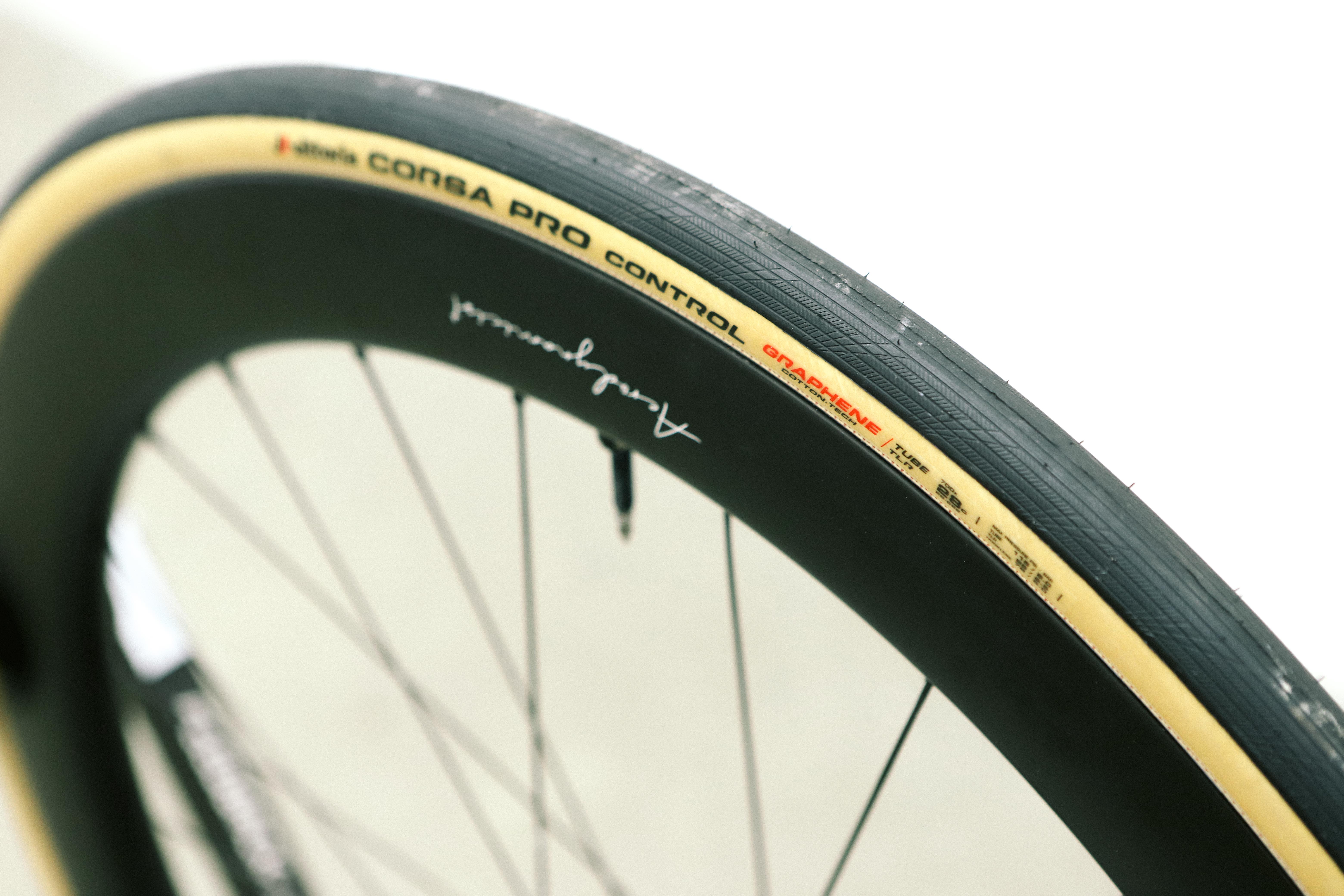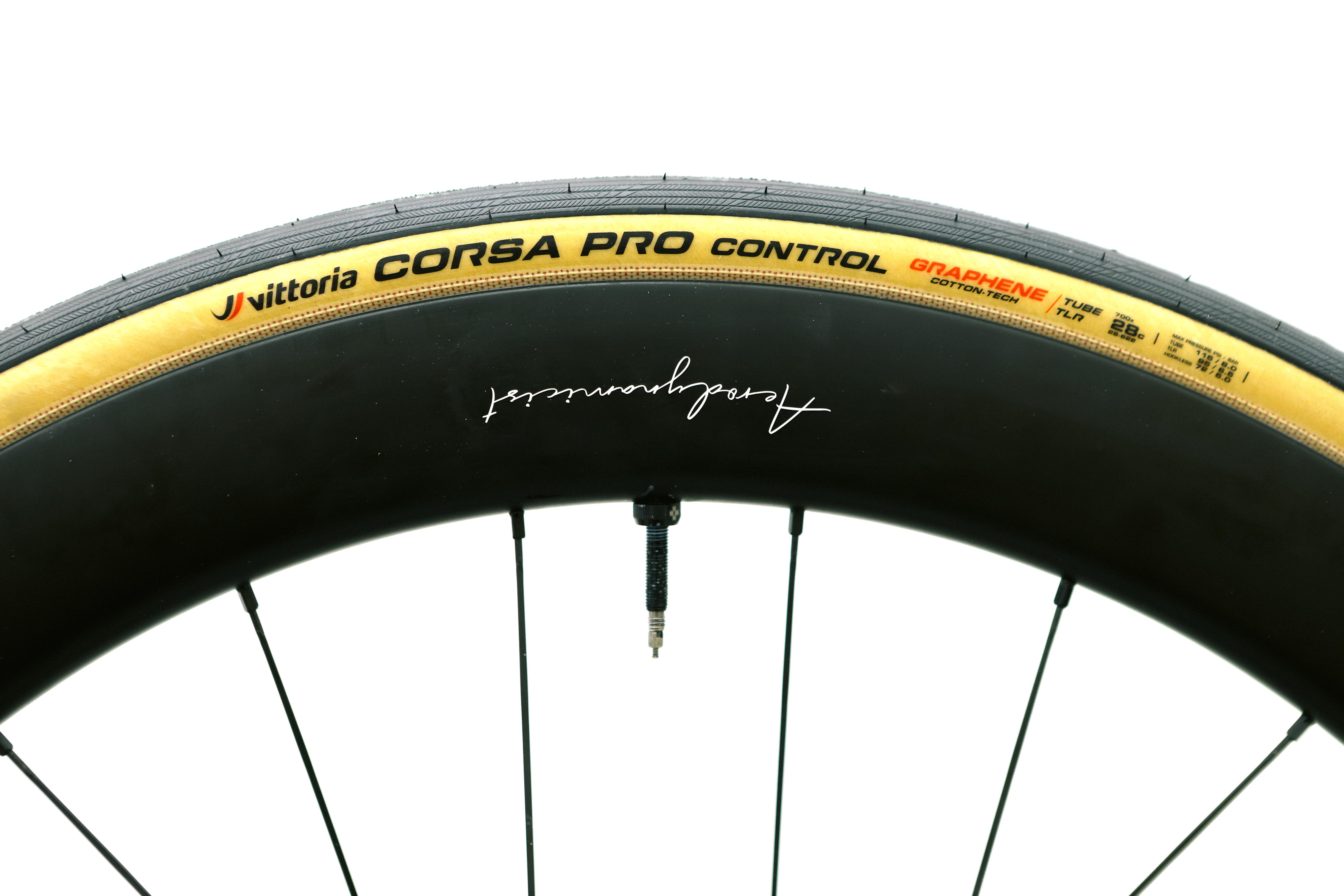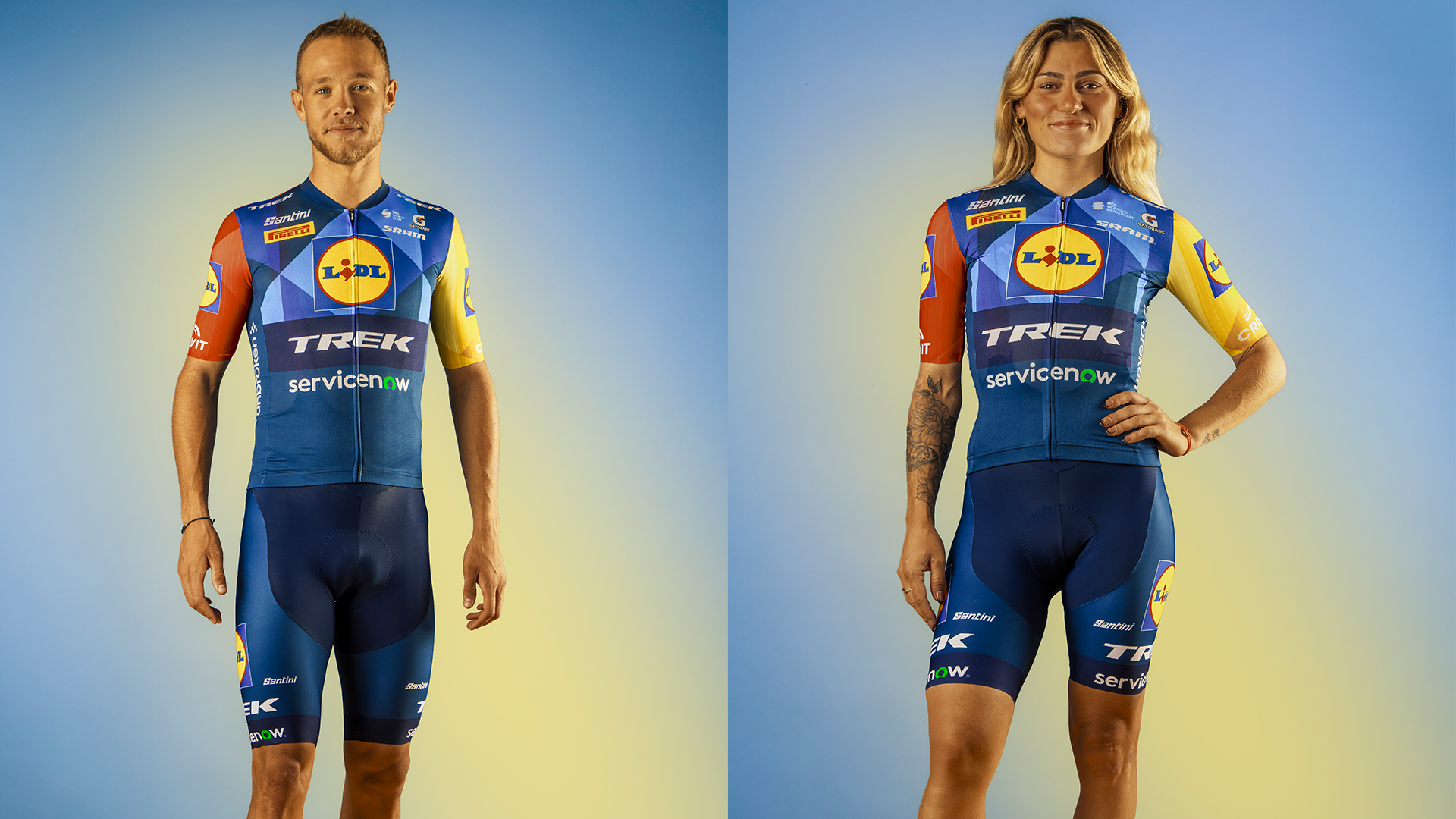Cyclingnews Verdict
Grippy, with great puncture proofing and stylish, but the rolling resistance doesn’t lie. Although it features the same compound as the blisteringly fast Corsa Pro Speed, the thicker more resistant tread hits the CRR. It’s hard to recommend these over the faster, lighter and cheaper Vittoria Corsa N.EXT.
Pros
- +
Grippy in most conditions
- +
Range of sizes available
- +
Tan wall looks great
- +
Easy to fit onto wheels
Cons
- -
Slow rolling resistance results in our testing
- -
Seating can prove difficult
- -
Sit a little narrower than advertised
- -
Outperformed by the cheaper Corsa N.EXT
You can trust Cyclingnews
Price: £89.99 / €95.95 / $106.99
Weight: 303 grams
Widths available: 26c, 28c, 30c, 32c, 34c
Measured width (28mm): 27.7mm
Tubeless ready: Yes
Hookless compatible: Yes except 26c
Released in May 2023 alongside the new and updated Vittoria Corsa line, the Corsa Pro Control tyre sits in the brand's top-tier lineup as a durable and longer-lasting yet still fast-paced tyre option.
Whereas the Corsa Pro is the all-day race tyre and the Corsa Pro Speed is the fragile yet blisteringly fast time trial option, the Corsa Pro Control you see here is designed to be used for training or races over rugged terrain.
Compared to the previous model, the new compound adds Silica to the Graphene mix, promising to be gripper, faster rolling, and longer lasting. The casing has apparently been bonded to the tread to improve security, while a new herringbone tread aims to improve wet weather grip.
Priced at £89.99 / €95.95 / $106.99, these are still a premium tyre and are made to be raced, as evidenced by their usage by team Visma-Lease a Bike and EF Education EasyPost during the 2024 Spring Classics.
But at such a premium price, how do they stack up against the best road bike tyres for racing, for all-round use, and against other premium winter tyres such as the GP5000 AS TR and Pirelli P Zero Race 4S TLR?

Design and specifications
The Vittoria Corsa Pro Control TLR tyres are the more endurance-based tyres in the brand’s Corsa Pro lineup. The Controls are designed to offer better puncture protection and mileage without sacrificing too much in terms of speed and weight. The tyres are built around a cotton casing, made with a 320tpi (threads per inch) construction to improve suppleness and smoother rolling, while also allowing for the classic tan wall look.
The outer of the tyre tread uses Vittoria’s Silica and Graphene 2C compound, which is the main change between these and the previous not ‘Pro’ version. Graphene has been used by Vittoria since 2015 and is a layer of carbon that is just one atom thick and has a multitude of interesting properties, not all of which are relevant to tyre performance.
The latest race content, interviews, features, reviews and expert buying guides, direct to your inbox!
The inclusion of graphene was designed to make Vittoria's tyres faster rolling, gripper, and more durable. Now, with the inclusion of Silica, this is meant to further reduce rolling resistance while also improving cornering grip, durability and puncture resistance. The use of the two materials has been graduated with different levels on the centre for fast rolling, the shoulders for enhanced grip, and the sidewall for improved puncture resistance. The tread is also thicker on the Control than the standard Corsa Pro and Speed variants, to additionally improve puncture protection with the same puncture belt as the Corsa Pro. An exclusive addition to the Control tyre is the Herringbone tread pattern on the shoulders promising additional grip in wet and foul weather.
Sizes start at 26mm wide and go all the way up to 34mm in 2mm increments. Only the tan sidewall colour is available, and all but the 26mm are ETRTO (European Tyre and Rim Technical Organisation) hookless tubeless compatible, which you can read more about here in our piece on what ETRTO standards mean.
A nice feature Vittoria offers is showing the carbon footprint of its products and how much cycling rather than driving is needed to offset that carbon. In this case, cycling for 21km instead of driving will offset the carbon footprint of one 26mm tyre. The factory is also part of CarbonNeutral operations.

Performance
A big plus of the Corsa Pro Control being a supple and easy-to-manipulate tyre is that fitting these on wheels is relatively very easy. For testing, I used a pair of Shimano RS170 alloy wheels which measure 23mm external and 17mm internal on the rim, and I was comfortably able to mount the tyres without levers. However, this ease of fitting may have contributed to it being a bit of a difficult process to mount the tyres to the rim hooks. I found that I had to remove the valve core and use a compressor with a big surge of air to get them to fit, and even then a bit of air seepage was still present until I got the wheels spinning in the frame.
Fitted onto these (admittedly narrow) wheels, the Corsa Pro Control measures up at 26mm rather than 28mm. Having tested the Corsa Pro on different wheels and found the same issue, I’d be inclined to believe it’s the tyre, not the rim affecting the width. In a separate test by the Cyclingnews tech team, we found them to measure 27.7mm on a Hunt 54 Aerodynamicist Disc wheelset with 20mm internal width. The P Zero Race 4S TLR measured 28.4mm, and the GP5000 AS TR measured 28.5mm on the same Hunt rim.
To put the tyres through their paces nicely, I looked for roads where there was plenty of debris and even sought out a few roads where I knew the hedges had recently been trimmed. Having put in a fair few hundred kilometres on these tyres, I’ve yet to have anything penetrate the tread and the wear has been next to nothing with the tread looking as fresh as when I started.
The tread is significantly thicker than that of the Corsa Pro and the Corsa Pro Speed, which is the main differentiator between the tyres. The only other main addition to the Corsa Pro Control is the presence of the herringbone tread to improve wet weather grip. It’s hard to say how much this impacts grip in wet weather, but I never felt in need of additional grip with these tyres even when cornering pretty hard.
Using them in a range of conditions with wet roads, patchy corners and heavier rain, they gripped brilliantly well and impressed me. My only slight concern which is yet to be realised as it requires a lot more time, is how the tread stays in contact with the casing over time. The previous generation of Corsa tyres had a bad habit of the tread peeling away from the casing after extended use. I personally found this would happen before the tread was at the end of its lifespan. Vittoria does say the two are now more securely bonded, and I have to take its word on that for the moment. From inspection alone, the bond looks to be more integrated and secure.
When it comes down to the performance figures, this is where the Vittoria Corsa Pro Control starts to unravel a bit. In our recent tyre rolling resistance testing at the Silverstone Sports Engineering Hub, the Corsa Pro Control were second bottom, beating only the all-season focussed Pirelli P Zero Race TLR 4S.
To test rolling resistance we made sure to standardise the bike, wheels, 28mm tyre width (where applicable), 73psi, cadence, and gear used for the rolling resistance testing. This ensured that the predominant changes we would measure would be changes in tyre rolling resistance. We then tested at both 9 and 11m/s (32.4km/h and 39.6km/h) to measure the watts required to keep each tyre at the speed.
It may be slightly surprising to see the Corsa Pro Control come second slowest, given they use the same technology as the fastest Corsa Pro Speed. That extra tread and puncture protection seems to have reduced the CRR (coefficient of rolling resistance) drastically. Given they are designed to be a more durable tyre, this was not a devastating result as we’d expect to see race day tyres perform better. What was a surprise was that the cheaper, same-weight, Corsa N.EXT performed 3.3w better (or a total of 6.6w over two tyres).
The only real difference between these two tyres is the price, sidewall colour, and measured width.
Value
At £89.99 / €95.95 / $106.99, the Corsa Pro Control are priced at the premium race tyre range and the same price as the racier and faster Corsa Pro, although prices do seem to vary between retailers.
This puts them above the likes of the Pirelli P Zero Race TLR 4S, and Vittoria’s second-tier Corsa N.EXT, and certainly classes them as a high-end tyre. Looking at our graph for rolling resistance losses or gains vs price, the Vittoria were again well towards the bottom of the pile.
Now speed isn't the only factor, we know. Grip, puncture resistance and longevity are other key factors. However, given the Vittoria Corsa N.EXT perform better in rolling resistance, weighs the same, and has in our experience better sidewall protection, there is little reason to recommend the Controls over them except if tan walls are a must. Even with current sale prices the Control still out-prices more durable and even better-performing tyres.
Verdict
The Vittoria Corsa Pro Control TLR tyres are a good pair of tyres. The grip is superb, the durability appears to be very strong, and they do look good if tan walls are something you like. The problem is they are priced like a race-day tyre.
For winter training there are cheaper alternatives that perform similarly well across the board, while there are better-performing tyres that are cheaper and more resistant. Given that the only reason for recommending these over some of the competition is the tan wall aesthetics. If you’re not fussed about that, go for something different.
| Attributes | Notes | Rating |
|---|---|---|
| Design and aesthetics | A wide range of available sizes, while the tan wall will be loved by some | 7/10 |
| Performance | Based on CRR testing they towards the bottom of the pile. However grip and puncture resistance is good. | 7/10 |
| Tubeless setup | Easy to mount, sometimes difficult to seat with a bit of effort required to prevent air seepage. | 6/10 |
| Weight | Pretty lightweight for a more rugged performance tyre. | 8/10 |
| Value | As expensive as race day tyres, and more expensive than more durable and faster competitors. | 5/10 |
| Overall rating | Row 5 - Cell 1 | 66% |

Freelance cycling journalist Andy Turner is a fully qualified sports scientist, cycling coach at ATP Performance, and aerodynamics consultant at Venturi Dynamics. He also spent 3 years racing as a UCI Continental professional and held a British Cycling Elite Race Licence for 7 years. He now enjoys writing fitness and tech related articles, and putting cycling products through their paces for reviews. Predominantly road focussed, he is slowly venturing into the world of gravel too, as many ‘retired’ UCI riders do.
When it comes to cycling equipment, he looks for functionality, a little bit of bling, and ideally aero gains. Style and tradition are secondary, performance is key.
He has raced the Tour of Britain and Volta a Portugal, but nowadays spends his time on the other side of races in the convoy as a DS, coaching riders to race wins themselves, and limiting his riding to Strava hunting, big adventures, and café rides.

